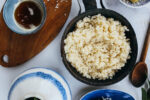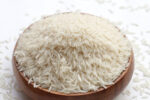Jasmine rice is a long-grain variety of fragrant rice primarily grown in Thailand, Cambodia, Laos, and southern Vietnam. It is known for its distinct floral aroma, soft texture, and slightly sticky consistency when cooked. Jasmine rice is a staple in Southeast Asian cuisine and is prized for its flavor and fragrance, often likened to the smell of pandan leaves or popcorn.
Characteristics of Jasmine Rice
Jasmine rice stands out due to several key traits:
- Aromatic: Jasmine rice has a naturally occurring compound called 2-acetyl-1-pyrroline, which gives it its characteristic floral scent, similar to pandan or freshly popped popcorn.
- Long, Slender Grains: The grains of jasmine rice are long and thin. When cooked, they become slightly sticky, making the rice soft and moist.
- Flavor Profile: It has a subtly sweet, buttery flavor, which makes it an excellent complement to savory dishes.
- Slightly Sticky Texture: While not as sticky as short-grain rice, jasmine rice does cling together slightly when cooked, giving it a pleasant, soft bite.
Types of Jasmine Rice
- White Jasmine Rice: This is the most commonly consumed type. It has been milled to remove the husk, bran, and germ, leaving behind polished white grains.
- Brown Jasmine Rice: Similar to white jasmine rice in aroma, but it retains its bran and germ layers. This gives it a nuttier flavor and a chewier texture while also providing more nutrients and fiber.
- Organic Jasmine Rice: Jasmine rice grown without synthetic pesticides or fertilizers, often available in both white and brown varieties.
Nutritional Profile of Jasmine Rice
White jasmine rice is a source of carbohydrates, but like other white rice varieties, it has been stripped of most of its fiber and nutrients during the milling process. A typical serving of cooked white jasmine rice (1 cup) contains:
- Calories: 180-205
- Carbohydrates: 40-45g
- Protein: 4g
- Fat: 0.5g
- Fiber: 0.5g
- Sodium: 0mg
Brown jasmine rice offers a more nutrient-dense option with higher fiber content (about 3g per cup) and additional micronutrients like magnesium, phosphorus, and B vitamins.
Culinary Uses of Jasmine Rice
Jasmine rice is versatile and pairs well with a variety of dishes, especially in Southeast Asian cuisine:
- Thai Curries: Jasmine rice is commonly served as a side to Thai curries, such as green curry or red curry, absorbing the flavorful sauces.
- Stir-Fries: Its subtle aroma and slight stickiness make it a perfect base for stir-fried dishes.
- Fried Rice: While jasmine rice is traditionally served steamed, it can also be used in fried rice dishes due to its fragrant quality.
- Rice Salads: Jasmine rice is often used in cold rice salads, mixed with vegetables, herbs, and dressings.
- Steamed Rice: A common side dish in many Asian cuisines, jasmine rice pairs well with grilled meats, fish, and vegetable dishes.
Preservation of Jasmine Rice
Proper storage of jasmine rice, both uncooked and cooked, is essential to preserve its distinctive aroma, texture, and flavor. Below are methods for storing and preserving jasmine rice:
Storing Uncooked Jasmine Rice
Jasmine rice, like other white rice varieties, has a relatively long shelf life when stored correctly:
- Pantry Storage: Uncooked white jasmine rice should be stored in an airtight container in a cool, dry place. If stored properly, it can last for up to 4-5 years. Brown jasmine rice, due to its higher oil content, has a shorter shelf life of about 6 months to 1 year.
- Refrigeration: To extend the shelf life of uncooked brown jasmine rice, it can be stored in the refrigerator. This can help prevent the natural oils in the rice from going rancid, extending its shelf life to 12-18 months.
- Freezing: Both white and brown jasmine rice can be frozen in sealed, airtight containers. Freezing uncooked rice helps preserve its aroma and texture and can keep it fresh for up to 2 years.
Preserving Cooked Jasmine Rice in the Fridge
Cooked jasmine rice, like other cooked rice, should be handled carefully to avoid bacterial growth:
- Cool Rice Quickly: Spread the cooked jasmine rice on a shallow tray to cool it down to room temperature within an hour.
- Refrigerate Immediately: Transfer the cooled rice into an airtight container and refrigerate. Cooked jasmine rice can last for 3-5 days in the fridge.
- Label and Date: Labeling the container ensures that you can track the freshness and consume it within the safe time frame.
Reheating Cooked Jasmine Rice
When reheating jasmine rice, it is important to ensure it reaches a temperature of at least 165°F (74°C) to kill any bacteria. Adding a little water helps restore the rice’s softness:
- Microwave: Add a tablespoon of water for every cup of rice, cover it with a microwave-safe lid, and heat on high until steaming.
- Stovetop: Place the rice in a saucepan with a splash of water, cover, and heat over medium heat until the rice is thoroughly warmed.
Other Methods of Preserving Cooked Jasmine Rice
- Freezing Cooked Jasmine Rice: Cooked jasmine rice can be frozen for up to 6 months. Portion the rice into freezer-safe bags or containers, removing as much air as possible before sealing. Reheat by thawing in the refrigerator overnight or microwaving directly from frozen.
- Vacuum Sealing: Vacuum-sealing cooked rice before freezing helps preserve its texture and prevents freezer burn. This method is especially useful for preserving large batches of rice for future use.
Health Benefits and Considerations of Jasmine Rice
While jasmine rice is a staple in many diets, its health benefits vary based on whether it’s white or brown jasmine rice:
- White Jasmine Rice: Similar to other refined grains, white jasmine rice is low in fiber and micronutrients but is still a good source of carbohydrates. It is easy to digest and provides quick energy, making it a common choice for those with digestive issues or those needing a readily available energy source.
- Brown Jasmine Rice: Brown jasmine rice retains its bran and germ layers, making it higher in fiber and nutrients. It is rich in vitamins and minerals such as magnesium, phosphorus, and B vitamins, and it has a lower glycemic index than white jasmine rice, making it a better option for individuals looking to manage blood sugar levels.
Risks and Considerations in Jasmine Rice Preservation
- Moisture Sensitivity: Jasmine rice can absorb moisture from the environment, which can affect its aroma and texture and lead to spoilage. It’s important to store it in airtight containers, particularly in humid climates.
- Bacterial Growth in Cooked Rice: Like all cooked rice, jasmine rice is susceptible to bacterial contamination if left at room temperature for more than two hours. It is crucial to refrigerate or freeze cooked rice promptly to avoid foodborne illnesses, such as those caused by Bacillus cereus.
Conclusion
Jasmine rice is a fragrant, soft, and versatile rice variety that complements a wide range of dishes, especially in Southeast Asian cuisine. With proper storage methods, uncooked jasmine rice can maintain its aroma and freshness for several years, while cooked jasmine rice can be preserved in the refrigerator or freezer for future use. Whether served as a side dish or used in more complex recipes, jasmine rice remains a popular and nutritious choice for many households around the world.





